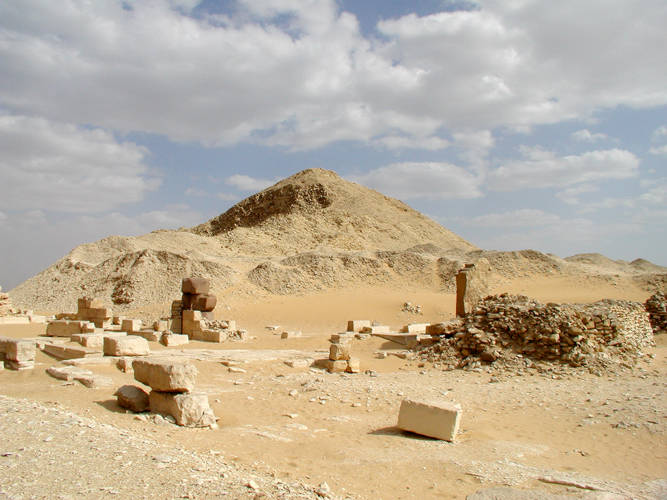Iput II on:
[Wikipedia]
[Google]
[Amazon]
:''About the river in Belarus and Russia see Iput River. For the early 6th dynasty queen, wife of
 Iput's pyramid complex consisted of a pyramid and a small mortuary temple. The temple was built in an L-shape. She was buried close to Pepi II at
Iput's pyramid complex consisted of a pyramid and a small mortuary temple. The temple was built in an L-shape. She was buried close to Pepi II at
Unas
Unas or Wenis, also spelled Unis ( egy, wnjs, hellenized form Oenas or Onnos), was a pharaoh, the ninth and last ruler of the Fifth Dynasty of Egypt during the Old Kingdom. Unas reigned for 15 to 30 years in the mid- 24th century BC (circa ...
see Iput
Iput I was a Queen of Egypt, a daughter of King Unas, the last king of the Fifth Dynasty of Egypt. She married Teti, the first Pharaoh of the Sixth Dynasty of Egypt. Their son was Pepi I Meryre.Dodson, Aidan and Hilton, Dyan. The Complete Royal ...
.''
Iput was an ancient Egyptian queen consort of the Sixth Dynasty
The Sixth Dynasty of ancient Egypt (notated Dynasty VI), along with the Third, Fourth and Fifth Dynasty, constitutes the Old Kingdom of Dynastic Egypt.
Pharaohs
Known pharaohs of the Sixth Dynasty are listed in the table below. Manetho acc ...
, a sister and wife of Pepi II
Pepi II Neferkare (2284 BC – after 2247 BC, probably either 2216 or 2184 BC) was a pharaoh of the Sixth Dynasty in Egypt's Old Kingdom who reigned from 2278 BC. His second name, Neferkare (''Nefer-ka-Re''), means "Beautiful is ...
.
Titles
Her titles King’s Daughter ''(z.t-nỉswt),'' and Eldest King’s Daughter ''(z.t-nỉswt-šms.t)'' show that Iput II was a daughter of a pharaoh, eitherPepi I
Pepi I Meryre (also Pepy I) was an ancient Egyptian pharaoh, third king of the Sixth Dynasty of Egypt, who ruled for over 40 years at the turn of the 24th and 23rd centuries BC, toward the end of the Old Kingdom period. He was the son of ...
or Merenre Nemtyemsaf I
Merenre Nemtyemsaf I (meaning "Beloved of Ra, Nemty is his protection") was an Ancient Egyptian pharaoh, the fourth king of the sixth dynasty. He ruled Egypt for six to 11 years in the 23rd century BC, succeeding his father Pepi I Meryre on th ...
. The title ''Hereditary Princess ''( ỉrỉỉ.t-pˁt) identifies her as a noble lady.
As a queen consort she held the following titles: King’s Wife ''(ḥm.t-nỉswt )'', King’s Wife, his beloved ''(ḥm.t-nỉswt mrỉỉ.t=f)'', Beloved King’s Wife of Neferkare-men-ankh ''(ḥm.t-nỉswt mrỉỉ.t=f nfr-k3-rˁ-mn-ˁnḫ),'' Beloved King’s Wife of Neferkare-men-ankh-Neferkare ''(ḥm.t-nỉswt mrỉỉ.t=f nfr-k3-rˁ-mn-ˁnḫ-nfr-k3-rˁ),'' and She who sees Horus
Horus or Heru, Hor, Har in Ancient Egyptian, is one of the most significant ancient Egyptian deities who served many functions, most notably as god of kingship and the sky. He was worshipped from at least the late prehistoric Egypt until the P ...
and Seth
Seth,; el, Σήθ ''Sḗth''; ; "placed", "appointed") in Judaism, Christianity, Islam, Mandaeism, and Sethianism, was the third son of Adam and Eve and brother of Cain and Abel, their only other child mentioned by name in the Hebrew Bible. A ...
''(m33.t-ḥrw-stš).
Burial
 Iput's pyramid complex consisted of a pyramid and a small mortuary temple. The temple was built in an L-shape. She was buried close to Pepi II at
Iput's pyramid complex consisted of a pyramid and a small mortuary temple. The temple was built in an L-shape. She was buried close to Pepi II at Saqqara
Saqqara ( ar, سقارة, ), also spelled Sakkara or Saccara in English , is an Egyptian village in Giza Governorate, that contains ancient burial grounds of Egyptian royalty, serving as the necropolis for the ancient Egyptian capital, Memphis. ...
and her tomb contains a version of the Pyramid Texts
The Pyramid Texts are the oldest ancient Egyptian funerary texts, dating to the late Old Kingdom. They are the earliest known corpus of ancient Egyptian religious texts. Written in Old Egyptian, the pyramid texts were carved onto the subterranea ...
.
In one of the storerooms of the mortuary temple excavators discovered the granite sarcophagus of Queen Ankhesenpepi IV, another wife of Pepi II. It is not entirely clear if Ankhesenpepi IV was originally buried in the burial complex of Iput II, or if she was originally interred elsewhere and reburied during the First Intermediate Period
The First Intermediate Period, described as a 'dark period' in ancient Egyptian history, spanned approximately 125 years, c. 2181–2055 BC, after the end of the Old Kingdom. It comprises the Seventh (although this is mostly considered spurious ...
.
Ankhesenpepi's sarcophagus is inscribed with an interesting historical text which sheds some light on the history of the early part of the 6th dynasty. The text inscribed on the sarcophagus has been very hard to decipher but at least partial translations have been possible. From the text it is now clear that Userkare
Userkare (also Woserkare, meaning "Powerful is the soul of Ra") was the second pharaoh of the Sixth Dynasty, reigning briefly, 1 to 5 years, in the late 24th to early 23rd century BC. Userkare's relation to his predecessor Teti and successor ...
reigned some four years, but the practice of ''damnatio memoriae
is a modern Latin phrase meaning "condemnation of memory", indicating that a person is to be excluded from official accounts. Depending on the extent, it can be a case of historical negationism. There are and have been many routes to , includi ...
'' later lead to his name being expunged from the records.Verner, M., The Pyramids: The Mystery, Culture and Science of Egypt's great Monuments
References